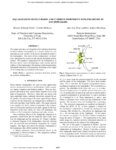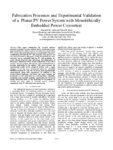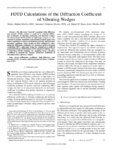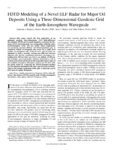Filters: Department: "Electrical & Computer Engineering" School Or College: "College of Engineering" Collection: "ir_uspace"
| Creator | Title | Description | Subject | Date | ||
|---|---|---|---|---|---|---|
| 226 |
 |
Stevens, Kenneth | Enhanced SDC support for relative timing designs | 2009-01-01 | ||
| 227 |
 |
Tasdizen, Tolga; Whitaker, Ross T.; Marc, Robert E.; Jones, Bryan W. | Enhancement of cell boundaries in transmission electon microscopy images | Transmission electron microscopy (TEM) is an important modality for the analysis of cellular structures in neurobiology. The computational analysis of neurons entail their segmentation and reconstruction from TEM images. This problem is complicated by the heavily textured nature of cellular TEM ima... | 2005 | |
| 228 |
 |
Mathews, V. John | Equalization of excursion and current-dependent nonlinearities in loudspeakers | This paper presents a novel equalizer for nonlinear distortions in direct-radiator loudspeakers in a closed cabinet by constructing an exact inverse of an electro-mechanical model of the loudspeaker. This exact inverse compensates for distortions introduced by excursion and current-dependent nonline... | 2014-01-01 | |
| 229 |
 |
Mathews, V. John | Equalization of recursive polynomial systems | Abstract-This letter presents some theorems for the exact and pth-order equalization of nonlinear systems described by recursive polynomial input-output relationships. It is shown that the nonlinear equalizers derived on the basis of this theory have simple and computationally efficient structures. ... | 1999 | |
| 230 |
 |
Rieth, Loren W | Excimer-laser deinsulation of Parylene-C coated Utah electrode array tips | Utah electrode arrays (UEAs) are highly effective to measure or stimulate neural action potentials from the central or peripheral nervous system. The measured signals can be used for applications including control of prosthetics (recording) and stimulation of proprioceptive percepts. The UEAs are co... | 2012-01-01 | |
| 231 |
 |
Harrison, Reid R. | Eyes and ears: combining sensory motor systems modelled on insect physiology | Integrating sensorimotor systems is still a difficult problems for robotics. Biological inspiration, which has been effectively used to address single sensorimotor tasks, could also be applied to this problem. Several studies on the cricket suggest that it integrates an optomotor response to two exi... | 2000-01-01 | |
| 232 |
 |
Mastrangelo, Carlos H. | Fabrication of localized plasma gold-tip nanoprobes with integrated microchannels for direct-write nanomanufacturing | We present the microfabrication and characterization of an AFM-tip like device with integrated gas delivery microchannel for the generation of localized microplasmas. The device plasma is generated within a submicron region around its tip for direct-write micro and nanofabrication. The device is fab... | 2012-01-01 | |
| 233 |
 |
Khan, Faisal Habib | Fabrication processes and experimental validation of a planar PV power system with monolithically embedded power converters | This paper summarizes the research outcome intended to identify the most suitable device architecture and its implementation for cell-level power conversion in a photovoltaic (PV) system. The fabrication process to accommodate the power conditioning unit with the PV cells using the same process run ... | 2012-01-01 | |
| 234 |
 |
Stevens, Kenneth | Family of 4-phase latch protocols | A complete family of untimed asynchronous 4-phase pipeline protocols is derived and characterised. This family contains all untimed protocols where data becomes valid before the request signal rises. Starting with a specification of the most parallel such protocol, rules are provided for concurre... | 2008 | |
| 235 |
 |
Mathews, V. John | Fast recursive least squares adaptive second-order volterra filter and its performance analysis | Abstract-This paper presents a fast, recursive least squares (RLS) adaptive nonlinear filter. The nonlinearity is modeled using a second-order Volterra series expansion. The structure presented in the paper makes use of the ideas of fast RLS multichannel filters and has a computational complexity of... | 1993 | |
| 236 |
 |
Tasdizen, Tolga | Fast semi-supervised image segmentation by novelty selection | The goal of semi-supervised image segmentation is to obtain the segmentation from a partially labeled image. By utilizing the image manifold structure in labeled and unlabeled pixels, semi-supervised methods propagate the user labeling to the unlabeled data, thus minimizing the need for user labelin... | 2010 | |
| 237 |
 |
Furse, Cynthia M. | Faster than fourier -- ultra-efficient time-to-frequency domain conversions for FDTD | Two highly efficient methods of computing magnitude and phase from time-domain data are demonstrated. These methods, based on solution of linear equations, are found to be equally accurate and more efficient than Fourier transform methods (DIT and FFT) for limited numbers of Frequencies. These metho... | Finite-difference time-domain method; FDTD; Fourier transform methods; Sine wave magnitude; Sine wave phase | 1998 |
| 238 |
 |
Furse, Cynthia M. | Faster than fourier: ultra-efficient time-to-frequency-domain conversions for FDTD simulations | This tutorial compares several methods of converting from the time to the frequency domain for FDTD simulations. Applications include calculations of field or power distributions, antenna impedance, and radiation patterns. The traditional Fourier transform methods are compared to two methods based o... | FDTD simulations; FDTD methods; Finite-difference time-domain; Computation time; Frequency domain analysis; Time domain analysis; Discrete Fourier transform | 2000-01-01 |
| 239 |
 |
Simpson, Jamesina J. | FDTD calculations of the diffraction coefficient of vibrating wedges | The full-vector Maxwell's equations finite-difference time-domain (FDTD) method is employed to calculate diffraction coefficients of vibrating conducting and dielectric wedges. Two-dimensional FDTD models of right-angle wedges are constructed to include total-field scattered-field incident plane-wav... | 2011-01-01 | |
| 240 |
 |
Furse, Cynthia M.; Gandhi, Om P.; Lazzi, Gianluca | FDTD computation of power deposition in the head for cellular telephones | The finite-difference time-domain method is used to calculate radiation pattern and specific absorption rate (SAR) in the human head due to cellular telephones. For realistic simulation of the ordinary positions of holding the phone, the ear of the model is pressed against the head, the head is tilt... | Finite-difference time-domain method; FDTD; Specific absorption rate; Radiation patterns; Human head model; Power deposition | 1996 |
| 241 |
 |
Simpson, Jamesina J. | FDTD modeling of a novel ELF radar for major oil deposits using a three-dimensional geodesic grid of the earth-ionosphere waveguide | This paper reports the first application of an optimized geodesic, three-dimensional (3-D) finite-difference time-domain (FDTD) grid to model impulsive, extremely low-frequency (ELF) electromagnetic wave propagation within the entire Earth-ionosphere cavity. This new model, which complements our pre... | 2006-01-01 | |
| 242 |
 |
Furse, Cynthia M. | Feasibility of reflectometry for nondestructive evaluation of prestressed concrete anchors | Concrete dams and other large civil structures utilize steel cable anchors to improve strength and stability. Reflectometry methods that have been used for location of faults in electrical systems are examined as a possible method for location and quantization of possible deterioration on concrete ... | Concrete anchors; Steel cable anchors; Reflectometry; Nondestructive evaluation; Spectral time-domain reflectometry | 2009-11 |
| 243 |
 |
Furse, Cynthia M. | Feasibility of spread spectrum sensors for location of arcs on live wires | Spread spectrum methods are an important emerging class of sensors that have the potential to locate small, intermittent faults on energized aircraft power circuit wires. Previous work has demonstrated the use of these methods for hard faults (open and short circuits). This paper extends that work ... | Spread spectrum sensors; Wire fault location; Live wires | 2005-12 |
| 244 |
 |
Tasdizen, Tolga; Whitaker, Ross T. | Feature preserving variational smoothing of terrain data | In this paper, we present a novel two-step, variational and feature preserving smoothing method for terrain data. The first step computes the field of 3D normal vectors from the height map and smoothes them by minimizing a robust penalty function of curvature. This penalty function favors piecewise ... | 2003 | |
| 245 |
 |
Mathews, V. John | Fixed-point error analysis of stochastic gradient adaptive lattice filters | Abstract-This paper presents a theoretical analysis of the stochastic gradient adaptive lattice filter used as a linear, one-step predictor, when the effects of finite precision arithmetic are taken into account. Only the fixed-point implementation is considered here. Both the unnormalized and norma... | 1990 | |
| 246 |
 |
Harrison, Reid R.; Charles, Cameron Townley | Floating gate common mode feedback circuit for low noise amplifiers | Most low noise amplifier designs focus on eliminating sources of noise that are intrinsic 1.0 the amplifier (thermal noise, Ilfnoise). As integrated (circuit design moves increasingly towards mixed signal implementations, the design of low-noise malog amplifiers must be re-evaluated to consider th... | Floating gate; Common mode feedback circuit; Low noise amplifiers | 2003-01-01 |
| 247 |
 |
Harrison, Reid R. | Floating gate current mirror for gain correction in CMOS translinear circuits | The exponential behavior of MOSFETs in subthreshold operation has recently been exploited to build CMOS translinear circuits such as multipliers and log-domain filters. A major obstacle in developing a practical CMOS implementation is the variation in threshold voltage between devices. In transline... | 1999-01-01 | |
| 248 |
 |
Harrison, Reid R. | Floating-gate PFET-based CMOS programmable analog memory cell array | The complexity of analog VLSI systems is often limited by the number of pins on a chip rather than by the die area. Currently, many analog parameters and biases are stored off chip. Moving parameter storage on chip could save pins and allow us to create complex programmable analog systems. In this ... | 2000-01-01 | |
| 249 |
 |
Harrison, Reid R. | Fly like a fly | THIS FALL, several biologist colleagues of mine plan to build a movie theater for houseflies. In fact, it's a miniature IMAX theater-complete with a panoramic screen-inside of which they'll place a tiny rotating cage, a downsized version of the ones that astronauts use to simulate tumbling in spa... | 2005 | |
| 250 |
 |
Harrison, Reid R. | Fly-inspired VLSI vision sensors | Engineers have long looked to nature for inspiration. The diversity of life produced by five billion years of evolution provides countless existence proofs of organic machines with abilities that far surpass those of our own relatively crude automata. We have learned how to harness large amounts of ... | 2002 |
